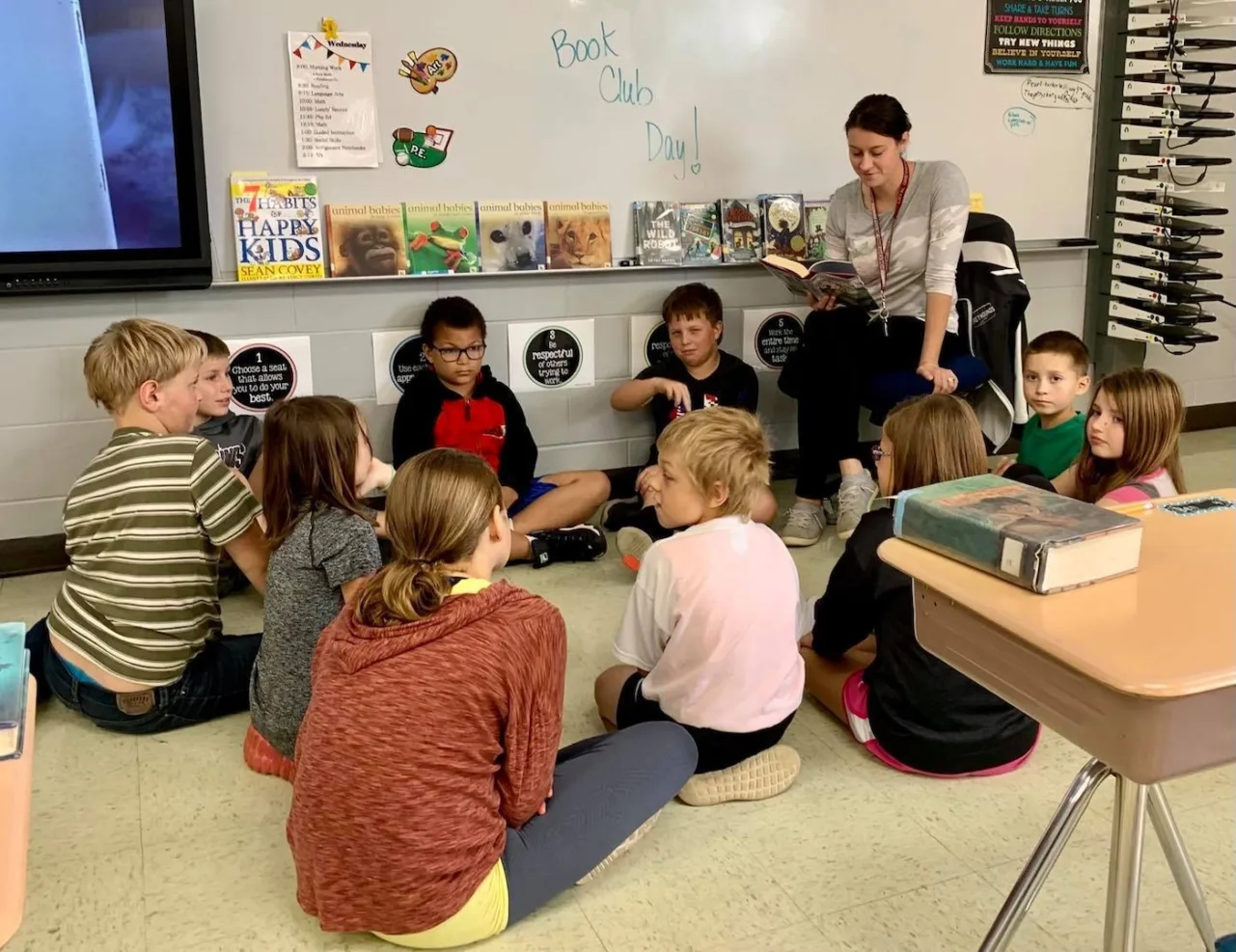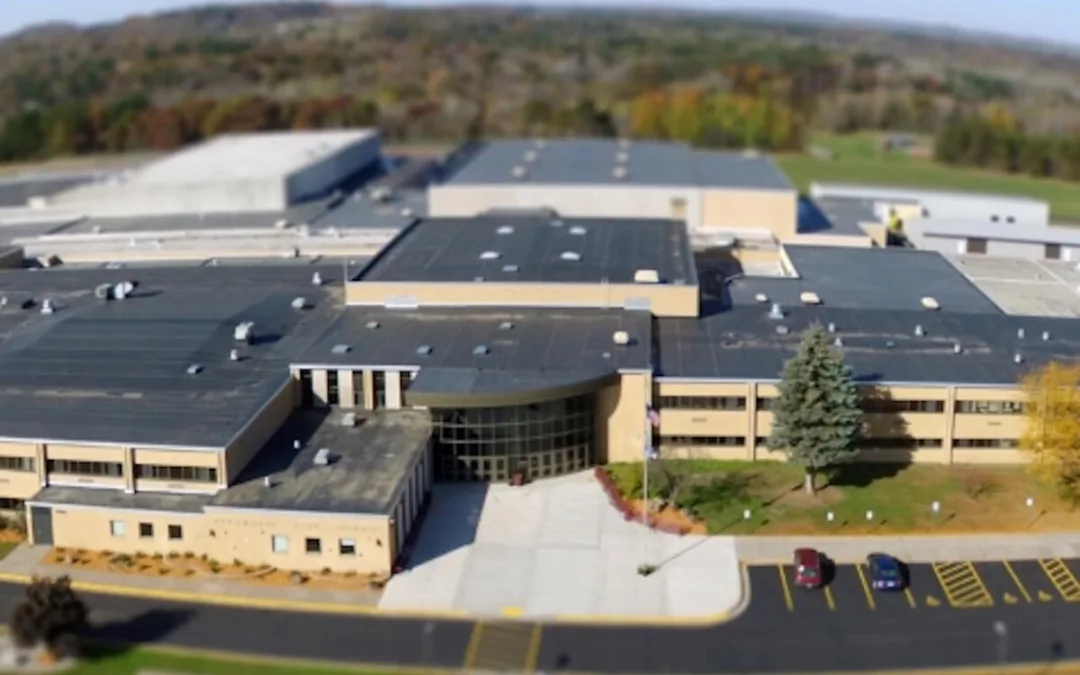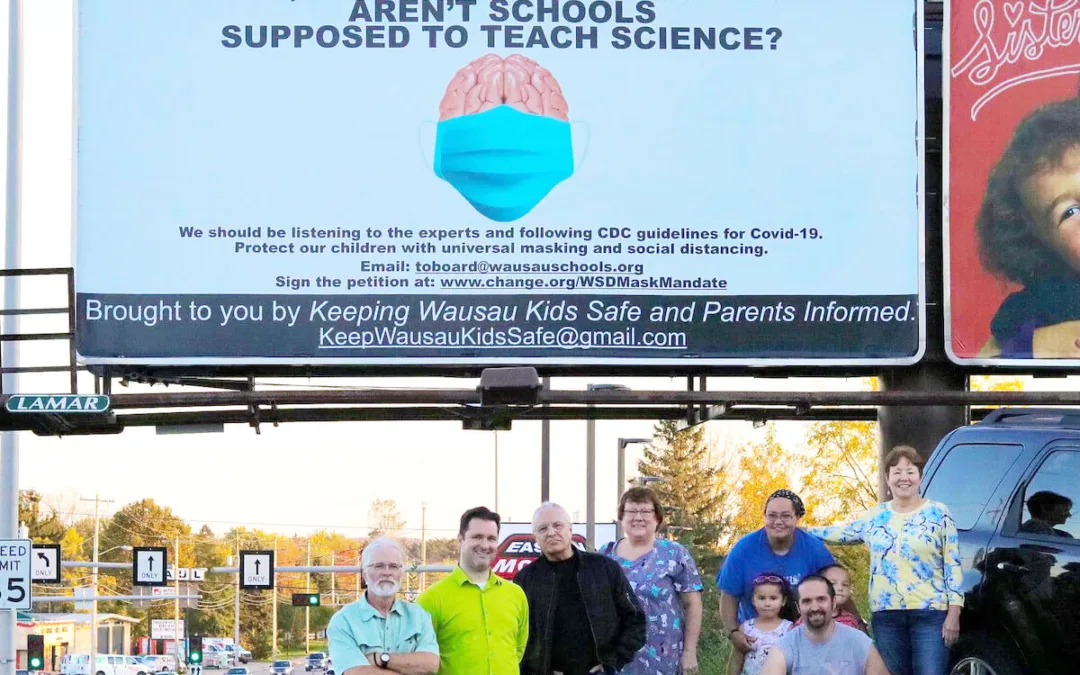
Kaila Fitzl, a teacher in the Loyal School District, with her class. (Photo courtesy of Kaila Fitzl)
There are 91 school referendums on ballots across the state for the April 2 spring election in Wisconsin. They’ve become a fixture as the Legislature has refused to provide public school funding that keeps up with inflation—for 16 consecutive years.
In her small-town Wisconsin community, Kaila Fitzl’s got an important vantage point—and therefore she has some priorities when it comes to her local public schools.
“As a teacher and a mom, my biggest thing is maintaining small class sizes,” Kaila said.
“There’s just a lot of research — students in small classes will perform better.”
Kaila and her husband Kyle both grew up in the rural Clark County community of Loyal. Because of the small-town values and the stellar schools they attended, they knew they also wanted to raise a family there.
“I prefer my kids to be in classes of 15-20,” the fourth grade teacher and mother of three said. “There are a lot of advantages.”
Kaila offers that the relationships between a student and teacher are stronger, there’s more one-on-one time, and there can be more tailored teaching to the needs of the student. But to keep classes small, school districts need funding—and in Wisconsin, referendums seem to be the only way to get it.
“If a referendum doesn’t pass, there’s a chance we’ll lose those class sizes,” Kaila said.
A referendum is a special vote on a single issue. For the upcoming April 2 election, people across Wisconsin will vote on 91 school referendums to help them fund their districts.
Kaila’s school district has had referendums on the ballot for the last four years. This year, it’s running on a five-year $6.7 million operational referendum that was passed in 2023.
“It’s just to keep the doors open,” Loyal School Superintendent Chris Lindner said.
Lindner’s four-year tenure at Loyal has seen three referendums. He speaks from experience that relief is short-lived.
“When it gets passed, it seems like you can relax for like a day, and then you say, ‘alright, let’s get back at it and start working on what we’re going to do next.’”
How are our schools funded?
K-12 education is Wisconsin’s leading public service. The state’s 421 K-12 public school districts educate more than 800,000 children each year.
School districts in Wisconsin are funded through a combination of state money and local property taxes. The amount each district gets depends on district property wealth and student characteristics.
Just like local property taxes change over time, so too does the funding commitment from the state budget—ideally, it would increase along with the cost of living and inflation.
But that’s not happening in Wisconsin.
According to the Wisconsin Policy Forum, in 2002 Wisconsin ranked 11th in the nation for school funding. By 2020, the state had fallen to 25th. This is the largest drop in the national ranking of any state over this time period. In fact, Wisconsin public school funding in 2020 was 6% below the national average.
What’s the problem?
“It doesn’t work,” Lindner said of the state’s funding formula. Why? School funding is capped at a limit imposed in the 1990s. Any revenue beyond what made sense back then has to be done through a referendum.
“We’ve been using the same thing for 30 years,” Lindner said. “It hasn’t changed, but costs have changed.”
Lindner said Loyal is not an outlier in needing extra property tax money. “There are about 100 districts going to referendum out of 400, so it’s an ongoing issue,” said Lindner. “We’re in the same boat.”
The Chippewa Falls Area School District is among those asking for a referendum April 2—not for new projects, but merely to afford current operations. According to business manager Chad Trowbridge, 86% of the state’s school districts have had to go to voters at some point over the past 30 years to seek higher property taxes to make up for the state shortfall.
Governor Tony Evers, a Democrat and former teacher, has been fighting to change the system. Back in the last state budget, when the Republican-majority state Legislature wanted to address low per-pupil funding for a single budget cycle, Evers used his partial veto powers to increase it by $325 per student per year for the next 400 years. Even so, that’s still about $75 per student less than what schools would need to keep up with the rate of inflation.
Enrollments are declining
That’s especially tough for those schools in rural areas, like Loyal, with only about 500 students.
In fact, enrollment in public schools across Wisconsin continues to decline, with the system seeing a drop of nearly 9,000 students from 2022-23 to the 2023-24 school year, according to the Wisconsin Department of Public Instruction.
“Seventy-five to 80% of our districts are declining enrollment, so when you’re declining, your funds are declining because you get so much per student,” Lindner explained. “So you have revenue going down and expenses going up.”
“It’s very hard to balance, so what do we do? We ask taxpayers to pass a referendum.”
Penalizing for saving
Lindner also notes that the funding formula actually penalizes a district that spends less. A district’s state aid is based on how much it spends, and if Loyal loses its referendum income, its state financial help will drop even more.
“They want you to spend your money, and if you don’t, you won’t get aided the next year,” Lindner said. “Regular businesses don’t operate like that.”
“That’s something you just shake your head at.”
Deciding what to cut
Had the measure failed last year, Lindner said the district would have had to make major cuts. In jeopardy were middle and high school clubs and activities like Future Farmers of America (FFA), Family, Career and Community Leaders of America (FCCLA), Future Business Leaders of America (FBLA), National Honor Society, Student Council, Drama, and Spanish Club. Besides clubs, they would have also eliminated field trips, middle school athletics, and more.
When that long list of potential cuts came out last year, it was hard to hear for Kaila, whose oldest daughter, even in 5th grade, already has hopes of being involved in FFA. “She loves animals, she’s big into 4-H,” she said. “If she didn’t have the opportunity to be in FFA, she’d be heartbroken.”
What’s more, about 47% of jobs in Clark County are related to agriculture, so not having programs like FFA would be a detriment for Wisconsin’s kids—who will eventually have to decide what career to pursue and where to live.
“Kids also come to school for sports and co-curriculars,” Lindner said. “It’d be a blow to our district.”
“It’d affect any school. I think kids would open enroll out to go to a school that had these things. I’m thankful it passed.”
As Wisconsin’s kids, parents, and educators live their day-to-day lives in between referendums, many experts are calling for a review of the 1990s law, for a change in Legislature priorities, or simply a change in Legislature.
“It’s a struggle to meet the needs of our students and it’s hard to keep up,” Kaila said. “Referendums are the only option to keep up and keep giving kids top-notch services.”
Politics

Biden makes 4 million more workers eligible for overtime pay
The Biden administration announced a new rule Tuesday to expand overtime pay for around 4 million lower-paid salaried employees nationwide. The...

Biden administration bans noncompete clauses for workers
The Federal Trade Commission (FTC) voted on Tuesday to ban noncompete agreements—those pesky clauses that employers often force their workers to...
Local News

Readers Poll: Top Bowling Alleys in Wisconsin
Looking for the best bowling in Wisconsin? Look no further! Our readers have spoken in our recent poll, and we have the inside scoop on the top...

8 Wisconsin restaurants Top Chef judges are raving about
Top Chef’s 21st season is all about Wisconsin, and on-screen, it’s already apparent that the judges feel right at home here. But, while filming in...




